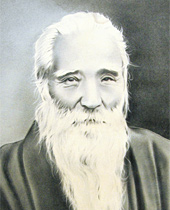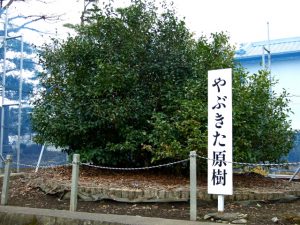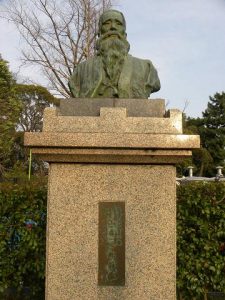
If you’re into Japanese tea, you may have heard about the Yabukita cultivar.
This tea cultivar was instrumental in the prosperity of the Japanese tea industry. It’s the most cultivated in Japan.
The story of the person that discovered Yabukita, Sugiyama Hikosaburō (杉山 彦三郎) is as interesting as the cultivar itself.
About Sugiyama Hikosaburō
Hikosaburō was born in 1857 in what is now Shizuoka city.
His father was a sake brewer and also a doctor of traditional Chinese medicine.
Hikosaburō decided to be a farmer instead, and so he let his younger brother take charge of the family’s business.
At that time, the tea industry was starting to grow rapidly. He started his own tea field, although he had no formal training.
The first years were hard because his tea’s quality was low. This was due to his lack of technical knowledge, especially in the aspect of tea processing.
Later on, thanks to Tada Motokichi (another important person in the history of Japanese tea) of the Department of Agriculture Encouragement of the time, he was able to learn about green tea and black tea processing.
Around the year 1877, when Hikosaburō was 20 years old, he met Yamada Fumisuke (山田文助) a distant relative who was a tea master.
Fumisuke made a very high quality tea that he rolled himself. He was very strict about the tea leaves that he used. Only soft buds of the right size and color would suffice.
Hikosaburō accompanied Fumisuke to pluck the necessary tea leaves, but he soon found that it was an arduous task.
The buds were scarce, because not all of the tea plants in the tea field had the same budding period. It was work that required several days.
Not only that, sometimes the softness wouldn’t be right, nor the color, etc. It was then when Hikosaburō realized that each tea plant had different characteristics.
Few people at that time knew about this. Tea farmers grew their tea plants from seeds, thus each tea plant in a given tea field had its own genetic differences.
Nowadays, tea cultivars are genetically identical and they aren’t propagated by seeds, precisely to avoid the appearance of different traits in each tea plant.
With cultivars, not only is a tea’s flavor, color and aroma uniform, but harvesting is much easier because the tea plants of the same cultivar produce buds at the same time.
Hikosaburō had an idea: if he found a good tea plant, it would produce good tea leaves, and that would result in a good tea.
This sounds very obvious now, but that idea was revolutionary in his time and place.
The quest of finding the best tea plant
He noticed that even if he took seeds from a tea plant that he considered to be good, the offspring wouldn’t have the same quality. Again, he lacked the necessary technical knowledge.
It took him some years of trial and error to find how to propagate a desirable tea plant, which is now done by cuttings.
And so he embarked on his quest with great enthusiasm.
The emphasis of the tea industry at the time was in processing and harvesting, but not on selective breeding. Many laughed at Hikosaburō’s pursuit because they considered it futile.
His neighbors sneered at him. His nickname was itachi (weasel in Japanese), because he would be inside other people’s tea fields looking for good tea plants in order to take a sample.
Once he found a desirable tea plant, he would take a branch with him and then propagate it in his tea field for testing purposes.
His passion knew no boundaries. He wouldn’t stop at Shizuoka and the neighboring prefectures, hence he ended up going as far as Okinawa and even Korea.
During his lifetime, he would catalogue at least 100 different cultivars.
But his most important discovery was the Yabukita cultivar.
Discovering the tea cultivar of the future
In 1908, in what is now Suruga ward in Shizuoka city, Hikosaburō found a tea field next to a bamboo grove.
He took two samples, one from the northern part and another from the southern part of the tea field.
“Takeyabu” is the Japanese word for bamboo grove, while “kita” means north, and “minami” means south
In that manner, he named the northern sample Yabukita and the southern one Yabuminami.
It was still too early to determine the overall quality of Yabukita, however.
Starting from zero
When he was 50 years old, he finally met someone that understood the value in what he was doing.
Ōtani Kahei (大谷 嘉兵衛) was the president of the tea industry council. He supported Hikosaburō by lending him a plot of land from the council and by taking care of the required expenses.
In his new testing field, Hikosaburō would keep records of a tea plant’s characteristics such as the resulting tea quality, yield at harvest, budding period (early budding, normal budding, and late budding), etc.
However, in 1927 Kahei resigned and thus Hikosaburō was left without his most important supporter.
In 1934, the tea industry council reclaimed the tea field where Hikosaburō had worked for more than 20 years. The tea plants where uprooted, piled up and incinerated.
It must have been one of the saddest days in the life of Hikosaburō. He was 77 years old.
Even at his old age, his passion remained strong. He went back to work with cultivars at his own tea field, this time with help from young neighbors.
He taught them all he knew, thus contributing to the next generation of local tea farmers.
Sugiyama Hikosaburō died in February 7 of 1941 after living for 84 years.
He didn’t live to see the prosperity that the Yabukita cultivar would bring, nor did he receive official recognition for his discovery while he was alive.
Hikosaburō’s Legacy
Later on tests would be done on Yabukita, and it was determined to be a superior cultivar. It was registered in 1953, 12 years after the death of Hikosaburō.
The cultivation of the Yabukita cultivar was encouraged in 1955 and it experienced explosive growth afterwards.

In Shizuoka city you can visit the original Yabukita tea tree, here’s the link to it in Google Maps.
I’m not sure how easy is it to take a picture of it like the one I found online.
It seems that in order to protect the tea plant from insects and the like, a blue net was placed around it.
Also, in Sunpu Castle Park (駿府城公園), there’s a small section at the north side called Marronnier park (マロニエ園).

The statue of Sugiyama Hikosaburō can be found there. (Google map link).
Sources:
http://www.ochakaido.com/rekisi/jinup/jinup09.htm
http://www.ochanomachi-shizuokashi.jp/stories/story05/





October 17, 2017
Thank you Ricardo for contributing to my tea knowledge! Such a fascinating post.
October 17, 2017
Hi Linda.
Thank you for reading, I’m very happy that you liked it.
October 17, 2017
Enjoyed reading this piece and learning about a significant person in Japanese tea history. If only he was rewarded for his efforts when he was alive.
October 18, 2017
Thank you for your comment Sherin.
It was unfortunate, but at least his legacy lives on.
October 19, 2017
Very interesting, thanks!
October 24, 2017
Very interesting article, thanks! Unfortunately, it seems that great artist must die in order to get famous…